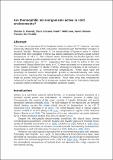Files in this item
Are thermophilic microorganisms active in cold environments?
Item metadata
| dc.contributor.author | Cockell, Charles S. | |
| dc.contributor.author | Cousins, Claire Rachel | |
| dc.contributor.author | Wilkinson, Paul T. | |
| dc.contributor.author | Olsson-Francis, Karen | |
| dc.contributor.author | Rozitis, Ben | |
| dc.date.accessioned | 2017-05-31T14:30:07Z | |
| dc.date.available | 2017-05-31T14:30:07Z | |
| dc.date.issued | 2015-07 | |
| dc.identifier | 206021937 | |
| dc.identifier | c6a54eb8-d16a-4244-b7e9-b84e44571f1c | |
| dc.identifier | 84929754206 | |
| dc.identifier.citation | Cockell , C S , Cousins , C R , Wilkinson , P T , Olsson-Francis , K & Rozitis , B 2015 , ' Are thermophilic microorganisms active in cold environments? ' , International Journal of Astrobiology , vol. 14 , no. 3 , pp. 457-463 . https://doi.org/10.1017/S1473550414000433 | en |
| dc.identifier.issn | 1473-5504 | |
| dc.identifier.other | ORCID: /0000-0002-3954-8079/work/60196591 | |
| dc.identifier.uri | https://hdl.handle.net/10023/10885 | |
| dc.description | The authors thank the STFC for providing a studentship to PW for this work. This work was made possible with support from the UK Science and Technology Facilities Council (STFC; Grant No. ST/1001964/1). | en |
| dc.description.abstract | The mean air temperature of the Icelandic interior is below 10 °C. However, we have previously observed 16S rDNA sequences associated with thermophilic lineages in Icelandic basalts. Measurements of the temperatures of igneous rocks in Iceland showed that solar insolation of these low albedo substrates achieved a peak surface temperature of 44.5 °C. We isolated seven thermophilic Geobacillus species from basalt with optimal growth temperatures of ~65 °C. The minimum growth temperature of these organisms was ~36 °C, suggesting that they could be active in the rock environment. Basalt dissolution rates at 40 °C were increased in the presence of one of the isolates compared to abiotic controls, showing its potential to be involved in active biogeochemistry at environmental temperatures. These data raise the possibility of transient active thermophilic growth in macroclimatically cold rocky environments, implying that the biogeographical distribution of active thermophiles might be greater than previously understood. These data show that temperatures measured or predicted over large scales on a planet are not in themselves adequate to assess niches available to extremophiles at micron scales. | |
| dc.format.extent | 7 | |
| dc.format.extent | 592085 | |
| dc.language.iso | eng | |
| dc.relation.ispartof | International Journal of Astrobiology | en |
| dc.subject | Thermophiles | en |
| dc.subject | Extremophiles | en |
| dc.subject | Volcanic | en |
| dc.subject | Mars | en |
| dc.subject | Geomicrobiology | en |
| dc.subject | GE Environmental Sciences | en |
| dc.subject | QC Physics | en |
| dc.subject | QB Astronomy | en |
| dc.subject | NDAS | en |
| dc.subject.lcc | GE | en |
| dc.subject.lcc | QC | en |
| dc.subject.lcc | QB | en |
| dc.title | Are thermophilic microorganisms active in cold environments? | en |
| dc.type | Journal article | en |
| dc.contributor.institution | University of St Andrews. Earth and Environmental Sciences | en |
| dc.identifier.doi | 10.1017/S1473550414000433 | |
| dc.description.status | Peer reviewed | en |
This item appears in the following Collection(s)
Items in the St Andrews Research Repository are protected by copyright, with all rights reserved, unless otherwise indicated.

